Your Fave?
Which is the stronger of today’s two featured images? All are invited to leave a comment and explain why they made their choice. I have a very clear favorite.
What’s Up?
On Monday morning, I checked on the two-egg crane nest in the North Marsh and was pleased to see the female sitting peacefully on her eggs. Next, I spent five good minutes in the sun with the crane family. When they headed back into the marsh, I headed home. Most of the day was spent working on my programs for the 2022 GNPA EXPO. I did my bursts, did my swim, and ate two healthy meals, the latter a far cry from the past weekend … It feels good to be back on the wagon. Monday evening was yet another busted sunset.
Today is Tuesday 15 March 2022. The forecast is calling for cloudy skies and an east/northeast breeze. I will head down to the lake early for a look-see. Wherever you are and whatever you are doing, I hope that you too had a great day. This blog post took about 90 minutes to prepare and makes six days in a row with a new one.
Please remember to use the B&H and Amazon links on most blog pages and to use the BIRDSASART discount code at checkout when purchasing your new gear from Bedfords. And please consider joining a BAA IPT. You will be amazed at how much you will learn …
March 2022 Indian Lake Estates In-the-Field Sessions
Two hours of intensive instruction: $200.00 (Add $100.00 if we are blessed with very small chicks). Add a working brunch with image review: $100.00. Sunny mornings with east winds are best. Likely subjects include ridiculously tame Sandhill Cranes and colts, a young Bald Eagle in the nest, Black and Turkey Vultures, Crested Caracara, Limpkin, Great Egret, Great Blue Heron, and more. Small crane chicks will hopefully be coming soon.
If you’d like to join me, please get in touch via e-mail or try me on my cell at 863-221-2372. Please leave a message and shoot me a text if I do not pick up.
Nikon Pacemaker Warning
Nikon has warned that people with pacemakers should avoid using the new autofocus system in their latest mirrorless lenses. You can read the whole story here.
From BPN-friend Kevin Hice via unsolicited e-mail
Again artie, that was a great trip. I was more than pleased. For me, I could see right away that you knew how to get us and the boat in great position for the best eagle photography. You took into consideration all the factors including the sky conditions, and wind and sun angles. It was a real pleasure to meet the captain. His knowledge of the wind and the currents helped to put us in great position all the time and he did his very best to help on all fronts.
One of the most important factors for me is timeliness. We never had to wait on the captain or on you, artie, and that made the trip a huge success. We got after it every day and had countless great photography opportunities. The other eagle photography tours never got out as early as we did, nor did they pursue the birds as relentlessly as we did.
One can never say that Arthur Morris doesn’t have the passion to get after the Bald Eagles. I have never shot as many photos as I did on this trip even with my poor hand eye coordination. I got plenty of keepers and enjoyed meeting the others in the group and learned a few things from them as well.
Thanks again, Kevin
Homer 2022 Bald Eagle Highlights and Handholding Compositional Tips by Arthur Morris/BIRDS AS ART
Enjoy and be inspired by just a few Homer Bald Eagle highlight images. Hand holding intermediate telephoto lens will always yield slightly different compositions. Learn more about that topic in this short (3:14) video.
|
|
|
2023 Homer/Kachemak Bay Bald Eagle IPTs
IPT #1: MON 20 FEB 2023 through the full day on FRI 24 FEB 2023. Five full days/20 hours on the boat: $5500.00. Limit 5 photographers
IPT #2: SAT 25 FEB 2023 through the full day on THURS 2 MAR 2023. Six full days/24 hours on the boat: $6600.00. Limit 5 photographers
IPT #3: FRI 3 MAR 2023 through the full day on TUES 7 MAR 2023. Five full days/20 hours on the boat: $5500.00. Limit 5 photographers/Openings: 4.
Save $1,000.00 by doing back-to-back trips. Save $1500.00 by doing all three.
This trip features non-stop flight photography as well as many opportunities to create both environmental and point-blank portraits of one of North America’s most sought-after avian subjects: Bald Eagle (Haliaeetus leucocephalus). Other reliable subjects will include Sea Otter, Glaucous-winged and Short-billed (formerly Mew) Gulls.
In addition, we should see Common Murre, Black Guillemot, Pelagic Cormorant, two or three species of loons, and a smattering of ducks including two species of merganser, all three scoters, Common and Barrow’s Goldeneyes, Bufflehead, Harlequin, and Long-tailed Ducks. Close-range photographic chances for these species will require a ton of good luck. Some of these species, especially when in flocks, can, however, often be used effectively when pleasing creating bird-scapes.
If we need to be out early, we will be the first boat out. If conditions are great, we will stay out. And when there is a chance for sunset silhouettes, we will be in the right spot.
We will be traveling through gorgeous wilderness country; landscape and scenic opportunities abound.
Also featured is a professional leader, often referred to as the world’s most knowledgeable bird photography trip leader, who is conversant in Canon, Nikon, and Sony. You will learn practical and creative solutions to everyday photographic problems. You will learn to see the shot, to create dynamic images by fine-tuning your compositions, to best utilize your camera’s AF system, and how to analyze the wind, the sky conditions, and the direction and quality of the light. This is one of the very few Homer trips available where you will not be simply put on the birds and told to have fun. You will learn to be a better photographer. But only if that is what you want.
You will learn to get the right exposure when it is sunny, when it cloudy-bright, when it is cloudy, when it is cloudy-dark, or when it is foggy. Not to mention getting the right exposure when creating silhouettes.
You will learn to make pleasing blurs working in manual mode and to create silhouettes working in Shutter Priority mode.
Most importantly you will learn to pick your best flight images from tens of thousands of images.
You will enjoy working with the two best and most creative boat captains on their sturdy, photography-spacious, seaworthy, open-deck crafts.
The second and third IPTs are the only Bald Eagle workshops that feature an incredibly helpful first mate.
Only five photographers (not the usual six), plus the leader.
Small group Photoshop, Image Review, and Image Critiquing sessions.
|
|
All images from Homer or Kachemak Bay, AK |
What’s Included
One four hour or two two-hour boat trips every day (weather permitting), all boat fees and boat-related expenses (excluding tips), ground transportation to and from the dock and back to the hotel each day, in-the-field instruction and guidance, pre-trip gear advice, small group post-processing and image review sessions, and a thank you dinner for all well-behaved participants.
What’s Not Included
Your airfare to and from Homer, AK (via Anchorage), the cost of your room at Land’s End Resort, all personal items, all meals and beverages, and tips for the boat captain and/or the first mate.
Please Note
On great days, the group may wish to photograph for more than four hours. If the total time on the boat exceeds 20 hours for the five-day trips, or 24 hours for the second trip, the group will share the additional expense at a rate of $225/hour.
Some folks may wish to rent their own vehicle to take advantage of local photographic opportunities around Homer.
Deposit Information
A $3000 non-refundable deposit/trip is required. You may pay your deposit with credit card or by personal check (made out to BIRDS AS ART) and sent via US mail only to Arthur Morris. PO Box 7245. Indian Lake Estates, FL 33855. Your balance, due 90 days before the date of departure, is payable only by check as above.
In Closing
I have been going to Homer off and on for close to two decades. Every trip has been nothing short of fantastic. Many folks go in mid-March. The earlier you go, the better the chances for snow. The only way to assure that you are on the best of the three trips is to sign up for all of them. Can you keep up with me? If you have any questions, or are good to go for one, two, or all three trips, please let me know via e-mail or give me a call on my cell phone at 863-221-2372.
|
|
|
This image was created on 19 February 2022, the scouting day for the 2022 Homer/Kachemak Bay Bald Eagle IPTs. I used the hand held Sony FE 70-200mm f/2.8 GM OSS II lens (at 200mm), and The One, the Sony Alpha 1 Mirrorless Digital Camera.. The exposure was determined via Zebras with ISO on the thumb wheel. ISO 1000: 1/2000 second at f/8 (stopped down two stops) AWB at 10:04.12am on a sunny day. Tracking: Zone AF/C with Bird-Eye/Face Detection performed perfectly. Click on the image to enjoy a high-res version. Image #1: Five Bald Eagles on gravel bar |
Nine Out of Ten Ain’t Bad
With regards to today’s two featured images, what does nine out of ten ain’t bad refer to?
High Level Image Design/Field-craft Question
One Tough Question
I really wanted to take one step more up the slope, but refrained from doing so in fear of scaring off one or more to the carefully arranged adult eagles. Why did I want to take one more step up the slope?
|
|
|
This image was created on 20 February 2022, day one of the first 2022 Homer/Kachemak Bay IPT. I used the hand held Sony FE 200-600mm f/5.6-6.3 G OSS lens (at 312mm), and The One, the Sony Alpha 1 Mirrorless digital camera. ) The exposure was determined using Zebra technology with ISO on the Thumb Dial. ISO 1600: 1/1000 second at f/6.3 (wide open). AWB at 11:51:21am in the shade on a cloudy-bright day. Tracking: Spot S with Bird/Face-Eye Detection performed perfectly. Be sure to click on the image to enjoy a high-res version. Image #2: Five Bald Eagles on radiolarian chert
|
Eagle-Scapes
There are lots and lots of eagles in Kachemak Bay in winter. Many of the small bays hold 60 to 100 eagles. Creating attractive bird-scapes is, however, a big challenge. Over the next few weeks, I will sharing lots more wide images featuring eagles in the landscape. Whenever you are striving to create effective bird-scapes, be on the lookout for one or more of these:
- 1- Great habitat as your background.
- 2- A pleasing arrangement of subjects.
- 3- Situations that are evenly lit, that is, with everything lit by the sun (Image #1), or with everything totally shaded (Image #2).
- 4- Good head angles for all the subjects (in small to medium-sized groups).
- 5- When working with relatively small groups of birds, do your best to avoid merges (with one bird overlapping another).
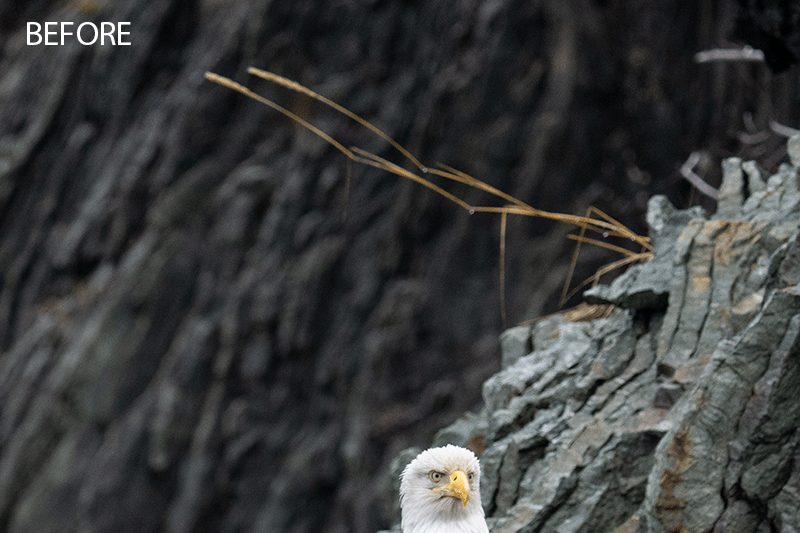
|
I Hated Those Sticks!
I hated those sticks from the moment that I saw the image in my mind, well before I raised my lens. And BTW, you can rarely create a successful image without first visualizing the shot. Removing them in post was easy. I used my usual cadre of clean-up tools and techniques including the Patch Tool, the Clone Stamp Tool, Content-Aware Fill, and Divide and Conquer.
|
|
The BIRDS AS ART Current Workflow e-Guide (Digital Basics II).You can order your copy from the BAA Online Store here, by sending a PayPal for $40 here, or by calling Jim or Jennifer weekdays at 863-692-0906 with your credit card in hand. Be sure to specify Digital Basics II. |
The BIRDS AS ART Current Workflow e-Guide (Digital Basics II)
The techniques mentioned above and tons more great Photoshop tips and techniques — along with all of my personalized time-saving Keyboard Shortcuts — are covered in detail in the BIRDS AS ART Current Workflow e-Guide (Digital Basics II), an instructional PDF that is sent via e-mail. Learn more and check out the free excerpt in the blog post here. While the new e-Guide reflects my MacBook Pro/Photo Mechanic/DPP 4/Photoshop workflow, folks using a PC and/or BreezeBrowser will also benefit greatly by studying the material on DB II. Note: folks working on a PC and/or those who do not want to miss anything Photoshop may wish to purchase the original Digital Basics along with DB II while saving $15 by clicking here to buy the DB Bundle.
Folks who learn well by following along rather than by reading can check out the complete collection of MP 4 Photoshop Tutorial Videos by clicking here. Note: most of the videos are now priced at an amazingly low $5.00 each.
You can learn how and why I converted all my Canon digital RAW files in DPP 4 in the DPP 4 RAW Conversion Guide here. More recently, I became proficient at converting my Nikon RAW (NEF) files in Adobe Camera Raw. About three years ago I began converting my Nikon and Sony RAW files in Capture One and did that for two years. You can learn more about Capture One in the Capture One Pro 12 Simplified MP4 Video here. The next step would be to get a copy of Arash Hazeghi’s “The Nikon Photographers’ Guide to Phase One Capture One Pro e-Guide” in the blog post here.
You can learn advanced Quick Masking and advanced Layer Masking techniques in APTATS I & II. You can save $15 by purchasing the pair.
Typos
With all blog posts, feel free to e-mail or to leave a comment regarding any typos or errors.

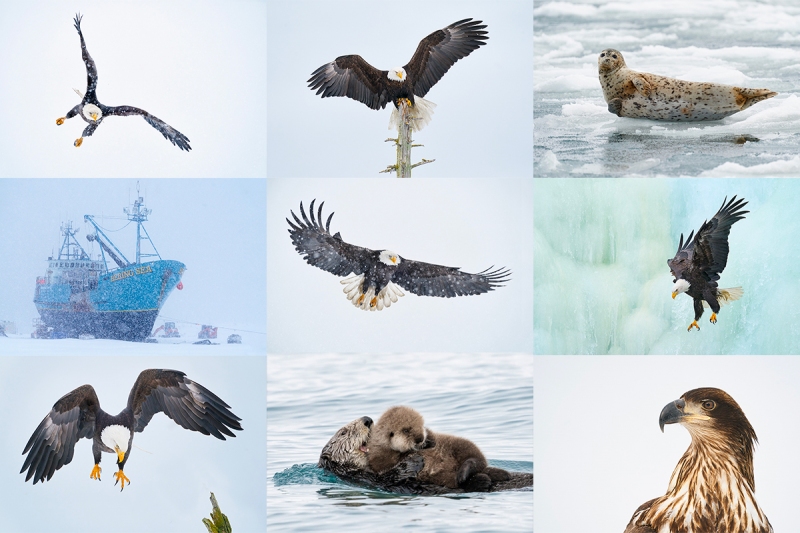
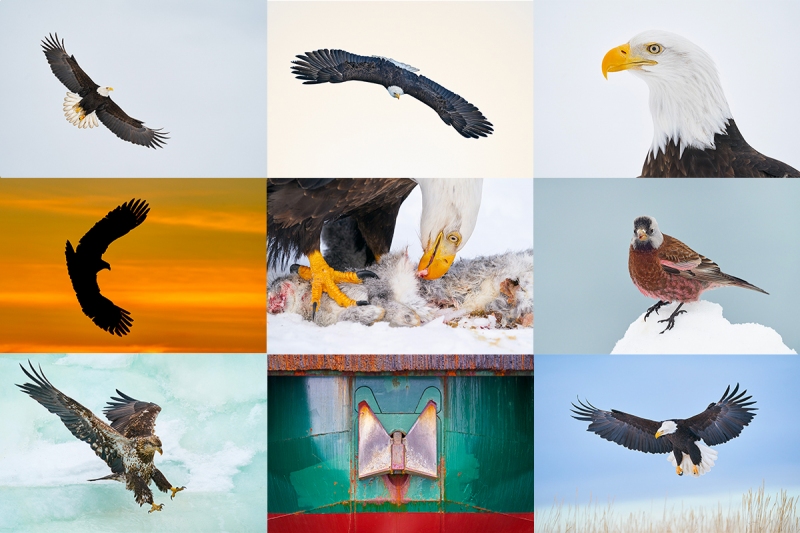
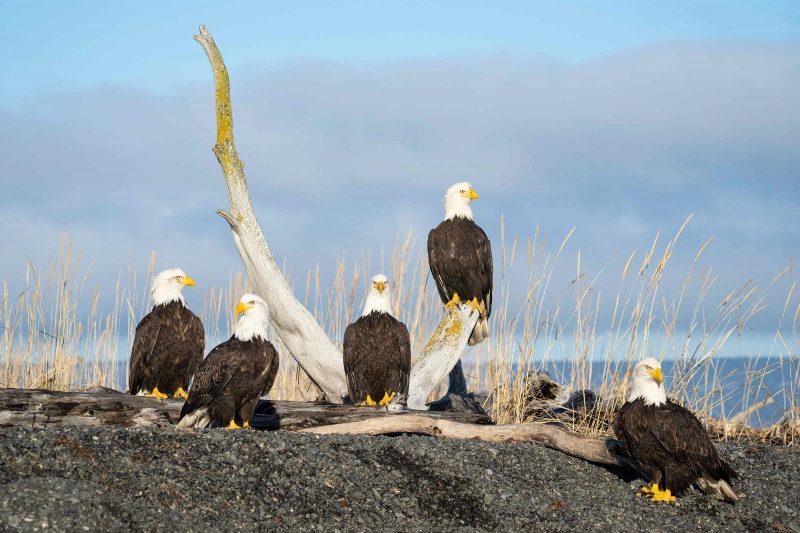
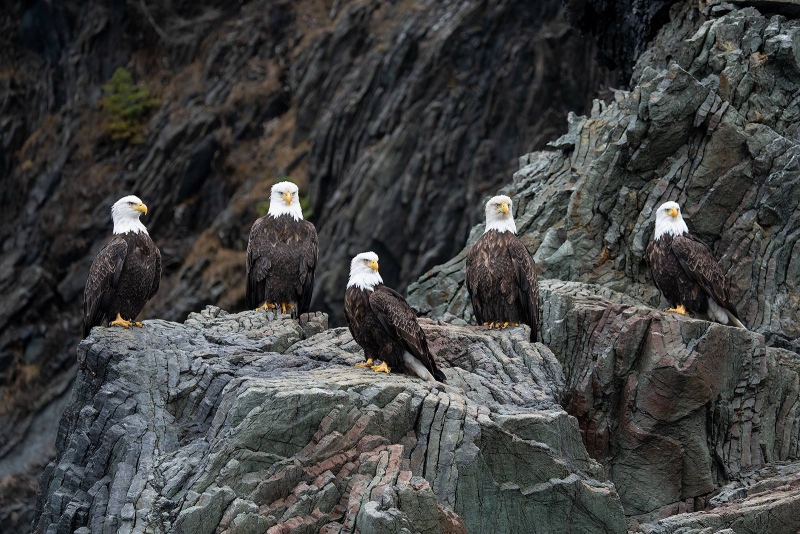














Sorry, I was agreeing with Joel Eade on head angle and think the center Eagle is the odd one of the ten. The forward stare looks a little goofy.
No worries. Goofy yes, but the head of the eagle on the left in #1 is turned away from us …
with love, artie
On #2, you can see 9 of the 10 eagle feet. Their bright yellow feet are one of my favorite features…
One more step up would raise the horizon above the Eagle’s head on the right in Image 1.
The one out of ten is the center Eagle in Image 1.
Bingo on #1. #2? Not so much.
with love, artie
Very nice both of them. My favorite is the second. I would guess the reason you “really wanted to take one step more up the slope” is the prevent the top of the head from merging with the rock edge (second eagle from our right), or maybe seeing more of the “platform” the eagle at the far right is standing on? Or both 🙂 Either way, it’s a winner of an image, and your question had me thinking hard…
Close but no cigar. The “one more step up the slope” question was in reference to Image #1. If you look there, I am pretty sure that you will see where I am going. The merge in #2 did not bug me.
with love, artie
Dan is a fabulous photographer and a Super-Moderator in the Avian Gallery at BPN.
Oh, oops, I thought it was for the second image. No wonder this had me over-thinking things ah ha ha! I see someone answered correctly since, so I won’t pretend that I got the answer now 🙂
Another way to get nine out of ten: five guidelines for eagle-scapes x two images. One minor merge would make nine out of ten rules met. The main reason I like the second image best, however, is the more unusual habitat.
A search on “regularian chert” shows only one hit–your blog post. Regularian seems to be Spanish. Any definitions? I’m interested in part because the rock in the photo resembles the thin vertically tilted layers at Hanna Point in the South Shetlands, but everything there is said to be volcanic rather than sedimentary.
Actually two merges …
As for the chert, I learned that by word of mouth. I could not find regularian either. Further searching revealed a likely mispronunciation … I believe that the rock in the photograph is radiolarian chert. Learn more and see a photo from Kachemak Bay here:
https://epod.usra.edu/blog/2018/11/pillow-basalts-and-radiolarian-cherts.html
So thanks for the good question and for setting the record straight, and for helping me correct my error.
with love, artie
ps: I will fix the error.
Whatever I say, it’ll be the other one you prefer! However, my preference is for the second image… the group almost too perfectly spaced out! The fact you were able to get all five in a single frame, is amazing.
Is that true?
a
An almost impossibly hard choice, but the rocks in #2 finally tipped the balance.
While I would post either on my wall, the 5 on chert would be my preference. The contrast of the smooth, rounded bird with the angular rocks would be the one I could leave up much longer.
9 out of 10: All 10 feet are seen but the claws are seen in 9 of 10.
Nice pict.
Thanks. I never noticed the partially hidden talons of the one bird. It brought to mind this quote from Shawshank Redemption here:
Seriously, how often do you really look at a man’s shoes?
with love, artie
Winner, winner, eagle dinner?
I’d be happy with either image though #2 is more emotive and dimensional. How about 2 out of 3 ain’t bad by a recently departed, best selling, artist?
I love Meat Loaf but right now I listen to John Prine all day every day.
with love, artie
9 out of 10 head angles?
Hey Doc, You are too smart.
with love, artie
ps: If I had kept some additional frames from the sequence for #1, I would likely have been able to make that ten out of ten 🙂
I love the first image, in which the eagles really stand out. In the second image, their heads stand out but not their brown bodies or even their yellow feet. In the first image, their beautiful brown plumage and yellow feet show to good advantage. I also love how the birds have arranged themselves around the dead tree!
I like the rocks better as well. I think the other background is a touch too bright.
Getting another step higher would have brought you closer to eye level.
Thanks, Bob. Agree on the birds on the rocks being the stronger image.
with love, artie
I’ll go with the Neil Diamond version: “eagles on the rocks”. The rugged background adds to their character, plus the bolder (pun intended) contrast adds to the image too, vs the grass in the first image. Very nice capture.
Ah, from the Jazz Singer — https://www.youtube.com/watch?v=d6dUBZf7PGI
Thanks for your pick.
with love, artie